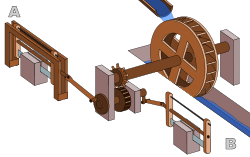

This list of ancient watermills presents an overview of water-powered grain-mills and industrial mills in classical antiquity, including the Hellenistic period through the Roman period up until circa 500 AD.
The water wheel and watermill are the earliest instances of machines harnessing natural forces to replace human muscular labour (apart from the sail).[3] As such, it holds a special place in the history of technology and also in economic studies where it is associated with growth.[4]
The invention of the watermill is a question open to scholarly discussion,[5] but is generally agreed to have occurred in the ancient Near East,[5][6] either before[6] or during the Hellenistic period.[7] In the subsequent Roman period, the use of water-power was diversified and different types of watermills were introduced. These include all three variants of the vertical water wheel as well as the horizontal water wheel.[8] Apart from its main use in grinding flour, water-power was also applied to pounding grain,[9] crushing ore,[10] sawing stones[11] and possibly fulling and bellows for iron furnaces.[12]
An increased research interest has greatly improved our knowledge of Roman watermill sites in recent years. Numerous archaeological finds in the western half of the empire now complement the surviving documentary material from the eastern provinces; they demonstrate that the breakthrough of watermill technology occurred as early as the 1st century AD and was not delayed until the onset of the Middle Ages as previously thought.[13] The data shows a wide spread of grain-mills over most parts of the empire, with industrial mills also being in evidence in both halves.[14] Although the prevalence of grain-mills naturally meant that watermilling remained primarily a rural phenomenon, it began gaining importance in urban environments during late antiquity.[15]
The data below spans the period until circa 500 AD. The vast majority are dated to Roman times.
- ^ Greene 2000, p. 39
- ^ Cite error: The named reference
Ritti, Grewe, Kessener 2000, 161was invoked but never defined (see the help page). - ^ Wilson 2002, p. 9
- ^ Wikander 2000a, p. 371
- ^ a b Wikander 2000a, pp. 394–6
- ^ a b Selin, Helaine (2013). Encyclopaedia of the History of Science, Technology, and Medicine in Non-Westen Cultures. Springer Science & Business Media. p. 282. ISBN 9789401714167.
- ^ Cite error: The named reference
inventionwas invoked but never defined (see the help page). - ^ Wikander 2000a, pp. 373–378; Donners, Waelkens & Deckers 2002, pp. 12–15
- ^ Wikander 1985, p. 158; Wikander 2000b, p. 403; Wilson 2002, p. 16
- ^ Cite error: The named reference
Wikander 2000b, 407was invoked but never defined (see the help page). - ^ Cite error: The named reference
Sawmillwas invoked but never defined (see the help page). - ^ Wikander 2000b, pp. 406f.
- ^ Wikander 1985, pp. 151–154; Wikander 2000a, pp. 370–373; Wilson 2002, pp. 9–17; Brun 2006, pp. 7–9
- ^ Wikander 2000a, pp. 397–400
- ^ Wikander 2000a, p. 379
© MMXXIII Rich X Search. We shall prevail. All rights reserved. Rich X Search
